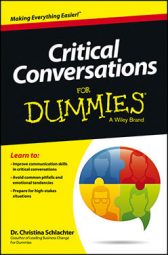Combining coaching with critical conversation skills can employees achieve and sustain top performance in support of organizational goals. Using coaching along with critical conversation methods can turn any positive dialogue into a five-star discussion.
Coaches provide feedback and encourage discussion that can influence changes in behavior, performance, or even beliefs. With proper coaching, an organization can reach new heights.
Coaching in organizations isn’t a time to show superiority. Starting with “I did it this way” or “I know what to do here” is training and lecturing, not coaching. Coaching starts with “This is what I liked about how you handled . . .” or “Is there anything you want to do differently next time?”
Mentoring is usually defined as an expert sharing information on how to do a task or role better, based on the mentor’s experience. Coaches help improve performance by creating a dialogue of what could work — and the ideas could come from the recipient or the coach.
Combine coaching methods with critical conversations
Coaching with critical conversation techniques can make your work relationships stronger and improve collaboration within a work group. Here are two ways to approach coaching:
Navigator of information: In this case, the coach guides an employee through mountains of information and approaches to solving a problem. A navigator coach is like a search engine on the Internet.
Imagine if you had to go through every possible website to find out how to lead business change or deliver a critical message to employees. You may be hunting for years! A coach would be able to direct you to the information that meets your needs in an efficient manner.
Giver of feedback: Provide feedback on the areas the person being coached identifies. This identification is the difference between having a critical conversation to improve performance, behavior, or actions and using critical conversation skills to coach the growth and development of an individual.
In coaching, the person being coached identifies what she wants to improve. In critical conversations, the manager or initiator usually identifies the areas of improvement.
Coaching gives you the opportunity to encourage an employee’s ambitions or goals. During a regular critical conversation to improve performance, the initiator has a specific goal in mind for the conversation. On the other hand, during a coaching conversation, the person being coached can identify areas she wants to improve.
Kick off this discussion by asking “What issues are you facing that have you stuck? What do you want to achieve through our discussion today?”
Even though the focus comes from different perspectives, the conversation and process still follow the same steps: examine what options are out there, decide what to do next, go and do it, and then evaluate how it went.
Coaching with critical conversations is different than a traditional manager-to-employee discussion, and even different than one-way feedback. This table shows some of these differences.
| Critical conversation skill | Managing employees traditionally | Coaching with critical conversation skills |
|---|---|---|
| Solving problems | Manager tells employee what to do. Can control solutions and next steps |
Coach explores & brainstorms options with employees, and together they create a plan of action. |
| Feedback | Manager lets an employee know what she did wrong or right. | Coach asks the employee what she felt she did well and what she would do differently. |
| Development and training | Manager informs employee of what she needs to improve. Focus on results and bottom-line fiscal improvement. |
Coach encourages the employee to explore options for doing things differently; coach and employee reflect on the results and make adjustments. |
A coaching conversation is a partnership, not a lecture. In a manager-to-employee discussion, the manager is usually in control and communicates to the employee. In a coaching conversation, the manager and employee engage in two-way conversation that encourages the employee to share ideas, concerns, and experiences. The coach may share ideas to steer a discussion, and the person being coached can then apply it to her day-to-day work.
Although not all situations are right for coaching, you can see how coaching can create a positive partnership, rather than a hierarchical relationship.
Coachable moments where you can use critical conversations
Coachable moments are simply times when you observe a behavior or action and can either tie that action or behavior to consequences or potential growth. Here are some examples of coachable moments that can help keep a top performer motivated:
Coachable moment Results. An employee accomplished a task that helped the organization meet its goals. This moment is the most common for positive feedback. Keep the energy flowing by providing specific details on outcomes and tying them to specific organizational goals. These coachable moments are great chances to link the big picture or the big organizational goals to the work that your high performers are doing every day.
Coachable moment Innovation. Did an employee use resources creatively or reengineer a process? If an organization values innovation, provide positive feedback when an employee creates a better and more effective way to do something.
Coachable moment Commitment and motivation. Although results are important, don’t forget to provide feedback on the commitment an employee has to the organization. If the team came together to solve a tough issue during a tight deadline, thank the employees for showing commitment to the goals.
Finding coachable moments isn’t just a tool to help employees keep performing like superstars; it’s also a way to give attention and support to high performers. Often, the low performers can take the majority of your time and energy. Using critical conversations in a positive way makes sure you give high and low performers consistent guidance and input.

